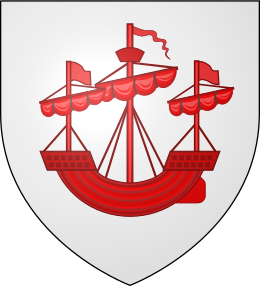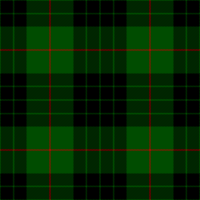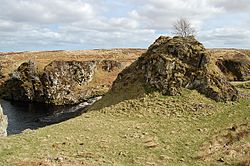Clan Gunn facts for kids
Quick facts for kids Clan Gunn |
|||
|---|---|---|---|
| Na Guinnich | |||
 |
|||
| Motto | Aut pax aut bellum (Either peace or war) | ||
| Profile | |||
| Region | Highlands | ||
| District | Sutherland and Caithness | ||
| Plant badge | Juniper | ||
| Pipe music | Failte na’n Guinnach (The Gunns' Salute) | ||
| Chief | |||
 |
|||
| Iain Alexander Gunn of that Ilk | |||
| The Gunn of Gunn | |||
| Historic seat | Gunn's Castle (Clyth Castle) | ||
|
|||
|
|||
|
|||
|
|||
Clan Gunn (called Na Guinnich in Gaelic) is an old Scottish clan. They come from the Highlands in northeastern Scotland. Their lands include Caithness, Sutherland, and sometimes the Orkney Isles. The Gunns are one of Scotland's oldest clans. Their ancestors were Norse Jarls (Viking chiefs) from Orkney. They also descended from the Pictish Mormaers (early rulers) of Caithness.
Contents
The Story of Clan Gunn
Where Did Clan Gunn Come From?
Old Stories and Legends
Clan Gunn's story begins with a man named Gunni. He came to Caithness in the late 1100s. His wife, Ragnhild, inherited land there. Her brother was Harald Maddadsson, the Earl of Orkney. Ragnhild was also related to St. Ragnvald. He founded the St Magnus Cathedral in Kirkwall, Orkney.
Gunni means "war." People say he was a descendant of Vikings. His grandfather, Sweyn, died in a raid on Dublin in 1171. Some historians, like Smibert, believe the Gunns were actually of Gaelic origin.
An old book from the 1600s, A Genealogical History of The Earldom of Sutherland, tells another story. It says the Gunns were "called Clan-Gun from one called Gun." This Gun was supposedly the "king of Denmarke his sone." He came from Denmark and settled in Caithness. However, old Gaelic storytellers called the Gunns "Lochlannaich," meaning Norwegians. This is because Norway was a separate kingdom when their ancestors arrived. It only joined Denmark later in 1391.
First Recorded Chief
The first chief of Clan Gunn to appear in official records was George Gunn. He was the crouner or coroner of Caithness in the 1400s. A coroner was an important local official. George Gunn was known as Am Braisdeach Mor, which means "the great brooch-wearer." This was because of a special badge he wore as coroner. People said George held court at his Clyth Castle with great style. His court was as grand as any other Highland chief's.
Clan Conflicts in the 1400s

In 1426, the Battle of Harpsdale took place. Clan Gunn fought against the Clan Mackay. The battle ended without a clear winner.
The Gunns had a long-standing rivalry with the Clan Keith. The Keiths lived in Ackergill Castle. They often fought the Gunns over land and power. In one story, a Keith named Dugald wanted to marry Helen, daughter of Gunn of Braemor. Helen did not want to marry him. When she was to marry another man, Dugald surrounded her father's house. He killed many people and took Helen to Ackergill Castle. Helen bravely jumped from the tower rather than marry him.
The Gunns fought back by raiding the Keiths' lands many times. However, they lost a battle in 1438 or 1464 called the Battle of Tannach. Both clans lost many people. They agreed to meet and settle their differences. This meeting is known as the Battle of Champions. Each side was supposed to bring twelve men on horseback. But the Keiths cheated. They brought two warriors on each horse. They then attacked and killed the outnumbered Gunns. The chief's last son, James, later got revenge. He killed Keith of Ackergill and his son at Drummoy.
Clan Conflicts in the 1500s
In 1517, Clan Gunn helped Clan Sutherland. They defeated the Clan Mackay at the Battle of Torran Dubh.
Alistair Gunn, son of John Robson Gunn, became a powerful man in the North. He married the daughter of John Gordon, 11th Earl of Sutherland. This made him feel very important. In 1562, he was with the Earl of Sutherland's group. They met James Stewart, 1st Earl of Moray, in Aberdeen. The Earl of Moray was a very important person. It was polite to move aside for someone of higher rank. Alistair refused to move from the middle of the street. This was a public insult to the Earl.
Soon after, the Earl of Moray had Alistair chased. He was caught by Andrew Munro of Milntown near Nairn. Alistair was taken to Inverness. After a quick trial, he was executed.
In the late 1500s, the Gunns had more conflicts. They fought against the Earl of Sutherland and the Earl of Caithness. In 1586, Clan Gunn won the Battle of Allt Camhna. But they were soon defeated by a much larger force at the Battle of Leckmelm.
The 1600s and Civil War
In the 1600s, Clan Gunn became closer to the Clan Mackay. The Gunn chief of Killearnan married Mary Mackay. She was the sister of Lord Reay, the chief of Clan Mackay. The next Gunn chief also married Lord Reay's daughter.
Another part of the clan was the Gunns of Bramore. They were known as the Robson Gunns. Sir William Gunn was the brother of the Robson chief. He fought in the army of the Protestant king of Sweden. He became a battalion commander. Later, he fought for King Charles I and became a knight in 1639. He then went back to Europe. He served the Holy Roman Empire and married a German baroness. He became an imperial general and was made a baron in 1649.
The 1700s and Jacobite Uprisings
Clan Gunn did not support the Stuarts during the Jacobite rising of 1745. Instead, they fought for the British Government. Alexander Gunn, the chief of Clan Gunn, was a Captain. He led an Independent Highland Company for the British Government.
However, some individual Gunns did fight for Bonnie Prince Charlie. You can find their names in a book called No Quarter Given. This book lists the soldiers in Prince Charles Edward Stuart's Army from 1745 to 1746.
Many Gunns also joined the 79th Queen's Own Cameron Highlanders regiment. They fought in the French Revolutionary and Napoleonic Wars.
Clan Leadership
On September 25, 2015, the Lord Lyon King of Arms for Scotland made an important decision. He officially recognized Iain Alexander Gunn of Banniskirk as the Chief of Clan Gunn. He is now known as Iain Alexander Gunn of that Ilk, Chief of Clan Gunn. This happened after a special meeting of the Clan Gunn family in Orkney on July 18, 2015. They asked the Lyon Court to recognize him. For the first time in 230 years, Clan Gunn has a recognized Chief. Iain had served as the Commander of Clan Gunn for over forty-three years before this.
Clan Commanders
Iain Alexander Gunn of Banniskirk became the second Commander of Clan Gunn. The Lord Lyon appointed him on June 9, 1972. He was also the Secretary of the Clan Gunn UK Society when it started in 1961. The first Commander was his uncle, William Gunn of Banniskirk. He held the title from 1967 to 1968.
In 1978, the chief of Clan Keith and the Commander of Clan Gunn signed a peace treaty. This happened at the site of the Chapel of St. Tayrs. This treaty officially ended the long-standing rivalry between the two clans, which had started in 1478.
Clan Castles
- Gunn's Castle (also called Clyth Castle) was on a rock by the sea. It was about eight miles southwest of Wick, Caithness. It was once a grand and strong castle. Now, almost nothing is left. The Gunns held this castle during their conflict with the Clan Keith.
- Dirlot Castle is near Watten, Caithness. It was first owned by the Cheynes. Then it went to the Gunns in the 1400s. Later, it was held by Clan Sutherland and then Clan Mackay.
- Halberry Castle is near Wick, Caithness. The Gunns held this castle. Now, only a few remains are left by the sea.
- Latheron Castle is near Dunbeath, Caithness. The Gunns held it, but it went to the Clan Sinclair in the 1600s. Only small parts of the castle remain. Latheron House was built in the 1700s.
- Kinbrace is a site where a castle once stood. It was held by the Gunns, but its exact location is not certain.
Clan Tartan
The Gunn tartan comes in different colors. You can find it in 'weathered', 'ancient', 'muted', and 'modern' styles.


